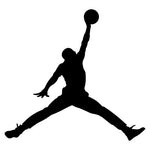The Complete History of the Air Jordan Brand: From 1984 to Global Icon
Ever wonder how a basketball shoe became one of the world's most famous brands? Well, you're about to find out.
The Air Jordan story isn't just about sneakers. It's about how one man's talent, mixed with smart business moves and a little controversy, created something that changed everything. From basketball courts to hip-hop videos, from high school hallways to fashion runways - Air Jordans are everywhere.
Here's the thing: understanding air jordan history helps you get why people still camp out for new releases 40 years later. It's not just about shoes anymore. It's about culture, status, and belonging to something bigger.
So let's dive in ad see how it all started.
The Origins: Michael Jordan's Path to Nike (1963-1984)
Michael Jordan's Early Life and Basketball Journey
High School Basketball Career
Michael Jordan wasn't always the superstar we know today. Back at Laney High School in North Carolina, he got cut from the varsity team as a sophomore. Instead of giving up, he used that rejection as fuel.
Jordan spent countless hours in the gym, growing taller and getting better. By his senior year, he was averaging 25 points per game. College scouts started paying attention.
University of North Carolina Era (1981-1984)
In 1982, as a freshman at UNC, Jordan hit one of the most famous shots in college basketball history. With 17 seconds left in the NCAA Championship game, he sank the winning basket against Georgetown. That shot? It launched a legend.
Jordan's college years showed everyone he was special. He could score, defend, and - most importantly - he never backed down from big moments. NBA teams took notice.
The Recruitment Battle: Nike vs. Adidas vs. Converse
Here's where things get interesting. In 1984, Jordan was heading to the NBA, and shoe companies wanted him bad.
The Initial Preference for Adidas
Believe it or not, Jordan actually wanted to sign with Adidas. He'd worn their shoes since high school and loved the brand. But Adidas made a huge mistake - they didn't think Jordan was worth the money. They offered him a basic deal and didn't even have the right shoe size for his visit!
Converse's Established Dominance
Converse seemed like the safe bet. They had Magic Johnson and Larry Bird locked up. Basketball was their game. But they weren't willing to pay Jordan what he wanted either.
Nike's Desperate Gamble
Nike was struggling in basketball. They were known for running shoes, not hoops. But Sonny Vaccaro, a Nike executive, saw something special in Jordan. He convinced Nike to make an offer they'd never made before.
Here's the kicker: Jordan's mom, Deloris, pushed him to hear Nike's pitch. Thank goodness she did.
The Landmark Deal: Nike's Game-Changing Partnership (1984)
The Negotiation Process
David Falk's Strategy
Jordan's agent, David Falk, knew they had leverage. He didn't just want money - he wanted something no athlete had ever gotten before. A signature shoe line. Stock options. Royalties.
The sports world thought he was crazy asking for so much.
Nike's Presentation
Nike pulled out all the stops. They showed Jordan a highlight video of his best dunks set to "Jump" by the Pointer Sisters. They had mock-ups of his first shoe design. They painted a picture of Jordan as the face of a brand, not just another endorser.
When Jordan criticized the shoe's colors, Nike listened. Other companies saw him as just another player. Nike saw him as a partner.
The Historic Contract Details
Financial Terms Breakdown
On October 26, 1984, Jordan signed a five-year deal worth $2.5 million. That was three times more than any NBA player had ever gotten from a shoe company.
But wait, there's more:
-
Stock options in Nike
-
His own signature shoe line
-
Royalties on every pair sold
-
Performance bonuses
What Made This Deal Different
Other athletes endorsed existing shoes. Jordan got his own brand within a brand. Nike bet their basketball future on one player. It was risky, but it worked.
The Birth of Air Jordan 1 (1985)
Design and Development
Peter Moore's Vision
Designer Peter Moore had a big job. He needed to create a shoe that matched Jordan's style - bold, athletic, and different. He used the Chicago Bulls' colors: black, red, and white.
The original "Wings" logo showed a basketball with wings. It was clean and simple.
Technical Innovations
The Air Jordan 1 wasn't just about looks. It featured:
-
Nike's air cushioning in the sole
-
High-top design for ankle support
-
Premium leather construction
-
Bold colorways that stood out on court
The "Banned" Marketing Genius
NBA's 51% White Rule
Here's where Nike got creative. The NBA had a rule that shoes needed to be mostly white to match team uniforms. The Air Jordan 1, with its black and red design, broke this rule.
The $5,000 Fines Strategy
Nike made a bold move. They told the NBA they'd pay Jordan's fines for wearing the shoes. Every game Jordan wore them, Nike cut a $5,000 check.
But here's the genius part - they turned those fines into marketing gold.
The Iconic "Banned" Advertisement
Nike's ad said: "On October 15, Nike created a basketball shoe. On October 18, the NBA threw them out of the game. Fortunately, the NBA can't keep you from wearing them."
The message was clear: these shoes were so good, the NBA banned them. People went crazy for them.
Launch and Initial Success
April 1, 1985 Release
When Air Jordan 1s hit stores, something special happened. They weren't just basketball shoes anymore - they were a statement.
Sales Performance
Nike hoped to make $3 million in the first three years. Instead, they made $126 million in year one alone. The Air Jordan was an instant hit.
The Tinker Hatfield Era and Design Changes (1987-1998)
The Game-Changing Air Jordan III (1988)
Tinker Hatfield's Design Philosophy
In 1987, Nike brought in Tinker Hatfield to redesign the Air Jordan line. Hatfield wasn't just a shoe designer - he was an artist. He looked at architecture, cars, and planes for inspiration.
His Air Jordan III changed everything. The elephant print pattern? Nobody had seen anything like it.
Introduction of the Jumpman Logo
Remember that famous photo of Jordan jumping with a basketball? That became the "Jumpman" logo on the Air Jordan III. It replaced the Wings logo and became one of the most famous symbols in sports.
The Golden Age Models (IV-XIV)
Air Jordan IV (1989) - Going Global
The Air Jordan IV was the first to be sold worldwide. Nike partnered with filmmaker Spike Lee for the ads, bringing street culture into the marketing.
The shoe appeared in Spike Lee's movie "Do the Right Thing," showing how Air Jordans were becoming part of popular culture.
Air Jordan V (1990) - Fighter Jet Style
Hatfield designed the Air Jordan V based on World War II fighter planes. It had a clear sole, reflective tongue, and shark-tooth design. Will Smith wore them constantly on "The Fresh Prince of Bel-Air."
Air Jordan VI (1991) - Championship Shoes
Jordan wore the Air Jordan VI when he won his first NBA championship. The shoe was inspired by German sports cars and featured clean lines and premium materials.
Air Jordan XI (1995) - The Patent Leather Classic
Here's the shoe everyone talks about. The Air Jordan XI mixed patent leather with a basketball shoe - something nobody thought would work. Jordan wore them in "Space Jam," and they became legendary.
Many people call the Air Jordan XI the best-looking basketball shoe ever made.
Air Jordan XIII (1997) - The Black Panther
The Air Jordan XIII was inspired by a black panther. It had a hologram on the heel that looked like a panther's eyes in the dark. In 2023, Jordan's game-worn pair sold for $2.2 million - the most expensive sneakers ever sold.
Air Jordan XIV (1998) - The Last Dance
Jordan's final championship came while wearing the Air Jordan XIV, inspired by his Ferrari. The black and red colorway became known as "The Last Shot" because Jordan hit the game-winning shot in the NBA Finals wearing them.
Technical Changes Through the Years
Air Cushioning Gets Better
Nike kept improving the air cushioning technology. They made it visible in some models, so you could actually see the air units in the sole. Full-length air cushioning provided better comfort and performance.
Material Improvements
From basic leather to patent leather to carbon fiber - each Air Jordan introduced new materials. These weren't just for looks - they made the shoes lighter, stronger, and more comfortable.
The Jordan Brand Goes Independent (1997-2003)
Brand Jordan Formation
September 22, 1997 Launch
In 1997, Nike did something smart. They made Jordan Brand its own separate company within Nike. This gave Jordan more control over his shoes and let the brand grow beyond just basketball.
After Jordan Retired
Air Jordan XV-XVIII
Even after Jordan retired (the first time), new Air Jordans kept coming. The Air Jordan XV was inspired by the X-15 aircraft. The Air Jordan XVII came with a CD-ROM. These shoes showed that Air Jordan was bigger than just Michael Jordan.
The Retro Revolution
Bringing Back the Classics
Here's where Nike got really smart. Instead of just making new shoes, they started re-releasing old ones. These "retro" shoes let new generations experience classic Air Jordans.
The retro strategy worked perfectly. People who missed out the first time could finally get their hands on Air Jordan I's or Air Jordan XI's.
Cultural Impact and Pop Culture Fame
Hip-Hop Culture Connection
1990s Rap Music Mentions
Rappers loved Air Jordans. Tupac, Biggie, Ice Cube, and Jay-Z all mentioned them in songs. When hip-hop artists wore Air Jordans, it wasn't just about basketball anymore - it was about style and status.
Status Symbol Development
In many communities, having the latest Air Jordans meant something. They showed you had good taste, money, and knew what was cool. This status symbol aspect made Air Jordans even more popular.
TV and Movie Appearances
Space Jam Cultural Impact (1996)
"Space Jam" starring Michael Jordan and Bugs Bunny was huge. The movie made $230 million worldwide and introduced Air Jordans to kids everywhere. The Air Jordan XI "Space Jam" colorway became one of the most wanted shoes ever.
Other Famous Appearances
Air Jordans showed up everywhere:
-
Will Smith wore different models throughout "The Fresh Prince of Bel-Air"
-
They appeared in Spike Lee's movies
-
Music videos featured them constantly
Celebrity Endorsements and Collaborations
Modern Collaboration Era
Today, Air Jordan works with artists and designers to create special versions:
-
Travis Scott's "Cactus Jack" Air Jordans
-
Virgil Abloh's Off-White collaborations
-
Even luxury brand Dior made Air Jordan 1s
These collaborations keep Air Jordan fresh and relevant for new generations.
The Rise of Sneaker Culture and Collecting
Sneakerhead Community Development
1980s Collection Beginnings
Some people started collecting Air Jordans from the very beginning. They'd buy multiple pairs, keep them in boxes, and trade with other collectors. This was the start of "sneakerhead" culture.
Internet Age Expansion
The internet changed everything. Collectors could connect worldwide, share photos, and trade shoes. Forums and websites became meeting places for sneaker fans.
Resale Market Evolution
Secondary Market Development
When stores sold out of popular Air Jordans, people started reselling them for more money. What started as small-scale trading became a massive business.
Modern Resale Ecosystem
Today, apps like StockX and GOAT make buying and selling sneakers easy. The resale market is worth over $2 billion. Some Air Jordans now cost more used than they did new!
Record-Breaking Sales
Rare Air Jordans sell for crazy money:
-
Michael Jordan's game-worn shoes: millions of dollars
-
Original 1985 Air Jordan 1s: $20,000+
-
Limited collaborations: $5,000+
Limited Edition and Special Releases
Collaboration Strategy
Nike learned that making fewer shoes makes people want them more. Limited releases create hype and long lines at stores.
Package Deals and Special Collections
Nike created special packages like:
-
"Defining Moments" packs with two shoes
-
Anniversary collections
-
Tribute releases honoring Jordan's career moments
Modern Era Jordan Brand (2004-Present)
Athletes Beyond Michael Jordan
NBA Player Endorsements
Jordan Brand now sponsors other basketball stars:
-
Chris Paul
-
Russell Westbrook
-
Jayson Tatum
-
Zion Williamson
These players get their own signature shoes, just like Jordan did.
Expansion to Other Sports
Jordan Brand moved beyond basketball:
-
Baseball player Aaron Judge
-
College football teams like North Carolina and Michigan
-
Soccer team Paris Saint-Germain
Digital Age Marketing and Social Media
Social Media Strategy
Jordan Brand uses Instagram, TikTok, and Twitter to connect with fans. They share behind-the-scenes content, athlete stories, and new releases.
E-commerce and Direct-to-Consumer
The Nike SNKRS app lets people buy limited releases directly. This creates excitement and makes releases feel like events.
Current Model Evolution (XIX-XXXIX)
Performance Technology Advancements
Modern Air Jordans feature:
-
Better cushioning systems
-
Lighter materials
-
Improved traction patterns
-
Feedback from current NBA players
Lifestyle and Fashion Integration
Many Air Jordans today work as both basketball shoes and fashion statements. They show up at fashion weeks and on red carpets.
Business Success and Financial Impact
Revenue Growth and Market Dominance
Current Financial Performance
Jordan Brand made Nike $5.1 billion in 2022. That's more than many entire companies make. Michael Jordan personally earned between $150-256 million just from his Nike royalties.
Impact on Nike Corporation
Jordan Brand helped transform Nike from a running shoe company into a lifestyle brand. It's Nike's most profitable division and shows no signs of slowing down.
Controversies and Challenges
Manufacturing and Labor Issues
Factory Working Conditions
Like many big brands, Jordan Brand faced criticism about factory conditions. Workers in Indonesia, Vietnam, and China went on strike for better wages and working conditions.
Nike has worked to improve these conditions, but critics say more needs to be done.
Social and Cultural Criticisms
Violence and Theft Related to Air Jordans
Sadly, some people have been hurt or killed for their Air Jordans. This led to school bans and discussions about whether expensive sneakers create dangerous situations.
Accessibility and Pricing Concerns
Air Jordans aren't cheap. Some people argue that high prices and limited releases make them impossible for many fans to afford.
Counterfeiting and Authentication
Fake Air Jordan Market
Fake Air Jordans are everywhere. Some fakes are so good that even experts have trouble telling the difference.
Authentication Technology
Nike and resale platforms now use special technology to verify authentic shoes. This helps protect buyers from fakes.
Global Impact and International Expansion
Worldwide Market Penetration
Air Jordan isn't just popular in America anymore. The brand has fans worldwide, from Asia to Europe to South America.
Cultural Adaptation Across Regions
Different countries embrace Air Jordans in their own ways. In some places, they're mainly basketball shoes. In others, they're fashion statements.
Innovation and Technology Changes
Performance Technology Timeline
Air Jordan technology keeps getting better:
-
Original Air cushioning evolved into Zoom Air
-
Materials became lighter and stronger
-
Designs became more scientific and performance-focused
Design Philosophy Evolution
Air Jordan designs reflect their times:
-
1980s: Bold and rebellious
-
1990s: Technical and performance-focused
-
2000s: Retro and nostalgic
-
2010s-present: Fashion and collaboration-focused
Legacy and Future Outlook
Cultural Legacy Assessment
Impact on Sneaker Industry
Air Jordan changed how athletes work with brands. Now every star athlete expects:
-
Their own signature shoe
-
Royalty payments
-
Creative input
-
Long-term partnerships
Broader Cultural Influence
Air Jordans proved that shoes could be more than functional items. They could be art, status symbols, and cultural statements.
Future Challenges and Opportunities
Market Saturation Concerns
With so many sneaker brands competing, Air Jordan needs to stay fresh and relevant. Younger consumers have more choices than ever.
Sustainability and Social Responsibility
Modern consumers care about how products are made. Jordan Brand must balance profit with environmental and social responsibility.
Upcoming Milestones and Predictions
40th Anniversary Preparations (2025)
2025 marks 40 years of Air Jordan. Expect special releases, celebrations, and retrospective collections.
Next Generation Strategies
To stay relevant, Jordan Brand must:
-
Connect with Gen Z consumers
-
Use new technologies like AR and VR
-
Create sustainable products
-
Maintain authenticity while innovating
Conclusion
The air jordan history is really the story of how sports, business, and culture came together to create something magical. What started as one basketball player's shoe deal became a global phenomenon that changed everything.
Air Jordan proved that with the right combination of talent, timing, and smart marketing, you can create something that lasts decades. From banned shoes to billion-dollar revenues, from basketball courts to fashion runways, Air Jordan became more than a brand - it became a cultural force.
The story isn't over yet. As we approach the 40th anniversary, Air Jordan continues to evolve while staying true to its roots. New generations discover the brand, while original fans stay loyal.
That's the real magic of Air Jordan - it connects different generations, cultures, and communities through a shared love of great design, performance, and style. Whether you're a basketball player, sneaker collector, or fashion enthusiast, Air Jordan has something for you.
And honestly? That's pretty amazing for a company that started with one player who almost signed with Adidas instead.
Frequently Asked Questions (FAQs)
What is the story behind Air Jordans?
Air Jordan started in 1984 when Nike signed Michael Jordan to an unprecedented deal. Instead of just endorsing existing shoes, Jordan got his own signature line. The first Air Jordan launched in 1985 and became famous when the NBA "banned" it for not being mostly white.
Why was Air Jordan 1 banned from the NBA?
The NBA had a rule requiring shoes to be 51% white. The black and red Air Jordan 1 violated this rule. Nike brilliantly used this "ban" in their marketing, suggesting the shoes were so good the NBA had to ban them.
Who brought Jordan to Nike?
Sonny Vaccaro, a Nike executive, convinced the company to pursue Jordan. Jordan's agent David Falk structured the deal, and Jordan's mother Deloris encouraged him to listen to Nike's pitch.
Is Jordan Brand still owned by Nike?
Yes, Jordan Brand is a subsidiary of Nike. However, it operates with significant independence and Michael Jordan maintains substantial input and financial benefits from the partnership.
How much did Jordans cost in 1985 vs. 1995?
The original Air Jordan 1 cost $65 in 1985. By 1995, Air Jordans typically cost around $125-140. Today, retro Air Jordans usually cost $170-200 or more.
Why are Jordans so expensive?
Several factors make Air Jordans expensive:
-
Premium materials and construction
-
Limited production numbers
-
High demand and brand prestige
-
Marketing and athlete endorsement costs
-
Resale market speculation
What are the most valuable Air Jordans ever sold?
Michael Jordan's game-worn Air Jordan 13s from 1998 sold for $2.2 million in 2023. Other expensive pairs include original 1985 Air Jordan 1s selling for $20,000+ and rare collaborations commanding thousands.
Where can you buy authentic Air Jordans today?
Shop with confidence: Denim Exchange is an officially authorized retailer of authentic Air Jordan sneakers.












